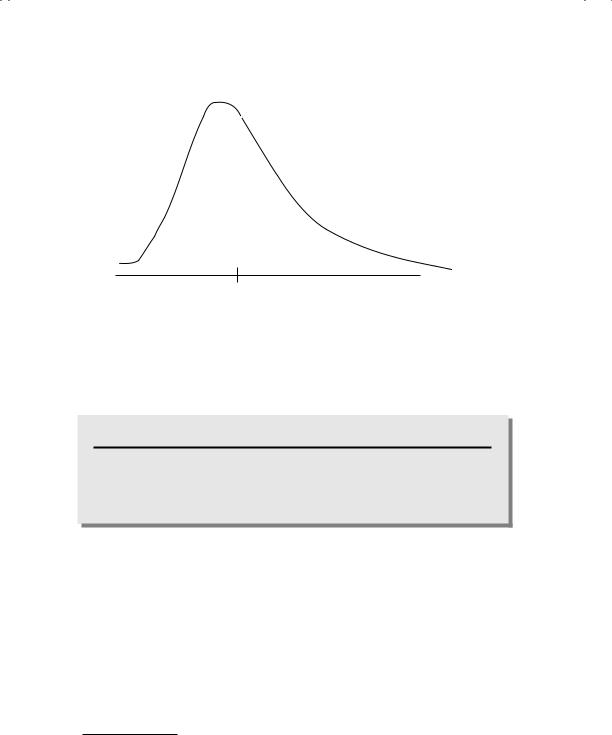
aswath_damodaran-investment_philosophies_2012
.pdf
10 |
INVESTMENT PHILOSOPHIES |
|
D E V E L O P I N G A N I N V E S T M E N T P H I L O S O P H Y |
|
|
If every investor needs an investment philosophy, what is the process that you go through to come up with such a philosophy? While this entire book is about the process, in this section we can lay out the three steps involved.
S t e p 1 : U n d e r s t a n d t h e F u n d a m e n t a l s o f R i s k a n d V a l u a t i o n
Before you embark on the journey of finding an investment philosophy, you need to get your financial tool kit ready. At the minimum, you should understand:
How to measure the risk in an investment and relate it to expected returns.
How to value an asset, whether it is a bond, stock, real estate holding, or business.
What the ingredients of trading costs are, and the trade-off between the speed of trading and the cost of trading.
We would hasten to add that you do not need to be a mathematical wizard to understand any of these, and we will begin this book with a section dedicated to providing these basic tools.
S t e p 2 : D e v e l o p a P o i n t o f V i e w a b o u t H o w M a r k e t s W o r k a n d W h e r e T h e y M i g h t B r e a k D o w n
Every investment philosophy is grounded in a point of view about human behavior (and irrationality). While personal experience often determines how you view your fellow human beings, before you make your final judgments you should expand this to consider broader evidence from markets on how investors act.
Over the past few decades, it has become easy to test different investment strategies as data becomes more accessible. There now exists a substantial body of research on the investment strategies that have beaten the market over time. For instance, researchers have found convincing evidence that stocks with low price-to-book value ratios have earned significantly higher returns than stocks of equivalent risk but higher price-to-book value ratios. It would be foolhardy not to review this evidence in the process of developing your investment philosophy. At the same time, though, you should keep in mind three caveats about this research:
1.Since they are based on the past, they represent a look in the rearview mirror. Strategies that earned substantial returns in the past may no

Introduction |
11 |
longer be viable strategies. In fact, as successful strategies get publicized either directly (in books and articles) or indirectly (by portfolio managers trading on them), you should expect to see them to become less effective.
2.Much of the research is based on constructing hypothetical portfolios, where you buy and sell stocks at historical prices and little or no attention is paid to transaction costs. To the extent that trading can cause prices to move, the actual returns on strategies can be very different from the returns on the hypothetical portfolio.
3.A test of an investment strategy is almost always a joint test of both the strategy and a model for risk. To see why, consider the evidence that stocks with low price-to-book value ratios earn higher returns than stocks with high price-to-book value ratios, with similar risk (at least as measured by the models we use). To the extent that we mismeasure risk or ignore a key component of risk, it is entirely possible that the higher returns are just a reward for the greater risk associated with low price-to-book value stocks.
Since understanding whether a strategy beats the market is such a critical component of investing, we will consider the approaches that are used to test a strategy, some basic rules that need to be followed in doing these tests, and common errors that are made (unintentionally or intentionally) when running such tests. As we look at each investment philosophy, we will review the evidence that is available on strategies that emerge from that philosophy.
S t e p 3 : F i n d t h e P h i l o s o p h y T h a t P r o v i d e s t h e B e s t F i t f o r Y o u
Once you understand the basics of investing, form your views on human foibles and behavior, and review the evidence accumulated on each of the different investment philosophies, you are ready to make your choice. In our view, there is potential for success with almost every investment philosophy (yes, even charting), but the prerequisites for success can vary. In particular, success may rest on:
Your risk aversion. Some strategies are inherently riskier than others. For instance, venture capital or private equity investing, where you invest your funds in small, private businesses that show promise, is inherently more risky than buying value stocks or equity in large, stable, publicly traded companies. The returns are also likely to be higher. However, more risk-averse investors should avoid the first strategy and focus on the second. Picking an investment philosophy (and strategy)

12 |
INVESTMENT PHILOSOPHIES |
that requires you to take on more risk than you feel comfortable taking on can be hazardous to your health and your portfolio.
The size of your portfolio. Some strategies require larger portfolios for success, whereas others work only on a smaller scale. For instance, it is very difficult to be an activist value investor if you have only $100,000 in your portfolio, since firms are unlikely to listen to your complaints. At the other extreme, a portfolio manager with $100 billion to invest may not be able to adopt a strategy that requires buying small, neglected companies. With such a large portfolio, the portfolio manager would very quickly end up becoming the dominant stockholder in each of the companies and affecting the price every time he or she trades.
Your time horizon. Some investment philosophies are predicated on a long time horizon, whereas others require much shorter time horizons. If you are investing your own funds, your time horizon is determined by your personal characteristics (some of us are more patient than others) and your needs for cash (the greater the need for liquidity, the shorter your time horizon has to be). If you are a professional (an investment adviser or portfolio manager) managing the funds of others, it is your clients’ time horizons and cash needs that will drive your choice of investment philosophies and strategies. You are only as long term as your clients allow you to be.
Your tax status. Since such a significant portion of your money ends up going to the tax collectors, taxes have a strong influence on your investment strategies and perhaps even the investment philosophy you adopt. In some cases, you may have to abandon strategies that you find attractive on a pretax basis because of the tax bite that they expose you to.
Thus, the right investment philosophy for you will reflect your particular strengths and weaknesses. It should come as no surprise, then, that investment philosophies that work for some investors do not work for others. Consequently, there can be no one investment philosophy that can be labeled “best” for all investors.
C O N C L U S I O N
An investment philosophy represents a set of core beliefs about how investors behave and how markets work. To be a successful investor, not only do you have to consider the evidence from markets, but you also have to examine your own strengths and weaknesses to come up with an investment philosophy that best fits you. Investors without core beliefs tend to wander from

Introduction |
13 |
strategy to strategy, drawn by the anecdotal evidence or recent successes, creating transaction costs and incurring losses as a consequence. Investors with clearly defined investment philosophies tend to be more consistent and disciplined in their investment choices, though success is not guaranteed to them, either.
In this chapter, we considered a broad range of investment philosophies from market timing to arbitrage and placed each of them in the broad framework of portfolio management. We also examined the three steps in the path to an investment philosophy, beginning with the understanding of the tools of investing—risk, trading costs, and valuation; continuing with an evaluation of the empirical evidence on whether, when, and how markets break down; and concluding with a self-assessment to find the investment philosophy that best matches your time horizon, risk preferences, and portfolio characteristics.
E X E R C I S E S
1.Get access to a comprehensive database that covers all or most traded companies in the market and has both accounting numbers for these companies and market data (stock prices and market-based risk measures like standard deviation).
a.If you are interested only in U.S. companies, you have lots of choices, with varying costs. You can always use the free data on Yahoo! Finance or similar sites, but they come with restrictions on data definitions and downloads. I use Value Line’s online data (cost of about $1,000 per year in 2011) and have used Morningstar’s online data as well (it requires a premium membership costing about $200 in 2011).
b.If you are interested in global companies, you have to be willing to spend more: Capital IQ and Compustat (both S&P products) and FactSet have information on global companies. The good news is that the choices are proliferating and getting more accessible.
2.It will make your life far easier if you are comfortable using a spreadsheet program. I use Microsoft Excel simply because of its ubiquity and power, but there are cheaper alternatives.
3.Also, check out my website (www.damodaran.com) and click on updated data. You will find sector averages for pricing multiples and accounting ratios, and data on stock returns and risk-free rates.


CHAPTER 2
Upside, Downside:
Understanding Risk
R isk is part of investing, and understanding what it is and how it is measured is essential to developing an investment philosophy. In this chapter, we lay the foundations for analyzing risk in investments. We present alternative models for measuring risk and converting these risk measures into expected returns. We also consider ways investors can measure their
risk aversion.
We begin with an assessment of conventional risk and return models in finance and present our analysis in three steps. In the first step, we define risk in terms of uncertainty about future returns. The greater this uncertainty, the more risky an investment is perceived to be. The next step, which we believe is the central one, is to decompose this risk into risk that can be diversified away by investors and risk that cannot. In the third step, we look at how different risk and return models in finance attempt to measure this nondiversifiable risk. We compare and contrast the most widely used model, the capital asset pricing model (CAPM), with other models, and explain how and why they diverge in their measures of risk and the implications for expected returns.
We then look at alternative approaches to measuring risk in investments, ranging from balance-sheet-based measures (using book value of assets and equity as a base) to building in a margin of safety (MOS) when investing in assets, and present ways of reconciling and choosing between alternative measures of risk.
In the last part of the chapter, we turn to measuring the risk associated with investing in bonds, where the cash flows are contractually set at the time of the investment. Since the risk in this investment is that the promised cash flows will not be delivered, the default risk has to be assessed and an appropriate default spread charged for it.
15

16 |
INVESTMENT PHILOSOPHIES |
W H A T I S R I S K ?
Risk, for most of us, refers to the likelihood that in life’s games of chance, we will receive an outcome that we will not like. For instance, the risk of driving a car too fast is getting a speeding ticket or, worse still, getting into an accident. Webster’s dictionary, in fact, defines risk as “exposing to danger or hazard.” Thus, risk is perceived almost entirely in negative terms.
In finance, our definition of risk is both different and broader. Risk, as we see it, refers to the likelihood that we will receive a return on an investment that is different from the return we expected to make. Thus, risk includes not only the bad outcomes (i.e., returns that are lower than expected) but also good outcomes (i.e., returns that are higher than expected). In fact, we can refer to the former as downside risk and the latter is upside risk; but we consider both when measuring risk. In fact, the spirit of our definition of risk in finance is captured best by the Chinese symbols for risk, which are reproduced here:
The Chinese Symbol for Risk
The first symbol is the symbol for “hazard” while the second is the symbol for “opportunity,” making risk a mix of danger and opportunity. It illustrates very clearly the trade-off that every investor and business has to make between the higher rewards that come with the opportunity and the higher risk that has to be borne as a consequence of the danger.
Much of this chapter can be viewed as an attempt to come up with a model that best measures the “danger” in any investment and then attempts to convert this into the “opportunity” that we would need to compensate for the danger. In financial terms, we term the danger to be risk and the opportunity to be the expected return.
E Q U I T Y R I S K : T H E O R Y - B A S E D M O D E L S
To demonstrate how risk is viewed in financial theory, we will present risk analysis in three steps. First, we will define risk as uncertainty about future returns and suggest ways of measuring this uncertainty. Second, we will differentiate between risk that is specific to one or a few investments and risk that affects a much wider cross section of investments. We will argue that in a market where investors are diversified, it is only the latter risk,

Upside, Downside: Understanding Risk |
17 |
called market risk, that will be rewarded. Third, we will look at alternative models for measuring this market risk and the expected returns that go with it.
D e f i n i n g R i s k
Investors who buy assets expect to earn returns over the time horizon that they hold the asset. Their actual returns over this holding period may be very different from the expected returns, and it is this difference between actual and expected returns that is the source of risk. For example, assume that you are an investor with a one-year time horizon buying a one-year Treasury bill (or any other default-free one-year bond) with a 5 percent expected return. At the end of the one-year holding period, the actual return on this investment will be 5 percent, which is equal to the expected return. The return distribution for this investment is shown in Figure 2.1. This is a riskless investment.
To provide a contrast to the riskless investment, consider an investor who buys stock in a company like Netflix. This investor, having done her research, may conclude that she can make an expected return of 30 percent on Netflix over her one-year holding period. The actual return over this period will almost certainly not be exactly 30 percent; it might even be much greater or much lower. The distribution of returns on this investment is illustrated in Figure 2.2.
In addition to the expected return, an investor has to note that the actual returns, in this case, are different from the expected return. The spread of
Probability = 1
The actual return is always equal to the expected return.
Expected Return |
Returns |
F I G U R E 2 . 1 Probability Distribution for Risk-Free Investment

18 |
INVESTMENT PHILOSOPHIES |
This distribution measures the probability that the actual return will be different from the expected return.
Expected Return |
Returns |
F I G U R E 2 . 2 Probability Distribution for Risky Investment
the actual returns around the expected return is measured by the variance or standard deviation of the distribution; the greater the deviation of the actual returns from expected returns, the greater the variance.
N U M B E R W A T C H
Most and least volatile sectors: Look at the differences between average annualized standard deviation in stock prices, by sector, for U.S. companies.
One of the limitations of variance is that it considers all variation from the expected return to be risk. Thus, the potential that you will earn a 60 percent return on Netflix (30 percent more than the expected return of 30 percent) affects the variance exactly as much as the potential that you will earn 0 percent (30 percent less than the expected return). In other words, you do not distinguish between downside and upside risk. This view is justified by arguing that risk is symmetric—upside risk must inevitably create the potential for downside risk.1 If you are bothered by this assumption, you could compute a modified version of the variance, called the semivariance, where you consider only the returns that fall below the expected return.
1In statistical terms, this is the equivalent of assuming that the distribution of returns is close to normal.

Upside, Downside: Understanding Risk |
19 |
It is true that measuring risk with variance or semivariance can provide too limited a view of risk, and there are some investors who use simpler stand-ins (proxies) for risk. For instance, you may consider stocks in some sectors (such as technology) to be riskier than stocks in other sectors (say food processing). Others prefer ranking or categorization systems, where you put firms into risk classes, rather than trying to measure a firm’s risk in units. Thus, Value Line ranks firms in five classes based on risk.
There is one final point that needs to be made about how variances and semivariances are estimated for most stocks. Analysts usually look at the past (stock prices over the prior two or five years) to make these estimates. This may be appropriate for firms that have not changed their fundamental characteristics—business or leverage—over the period. For firms that have changed significantly over time, variances from the past can provide a very misleading view of risk in the future.
D i v e r s i f i a b l e a n d N o n d i v e r s i f i a b l e R i s k
Although there are many reasons that actual returns may differ from expected returns, we can group the reasons into two groups: firm-specific and marketwide. The risks that arise from firm-specific actions affect one or a few companies, whereas the risks arising from marketwide actions affect many or all investments. This distinction is critical to the way we assess risk in finance.
T h e C o m p o n e n t s o f R i s k When an investor buys stock, say in a company like Boeing, he or she is exposed to many risks. Some risk may affect only one or a few firms, and it is this risk that we categorize as firm-specific risk. Within this category, we would consider a wide range of risks, starting with the risk that a firm may have misjudged the demand for a product from its customers; we call this project risk. For instance, consider the investment by Boeing in the Dreamliner, its newest jet. This investment was based on the assumption that airlines wanted larger, more updated aircraft and would be willing to pay a higher price for them. If Boeing has misjudged this demand, it will clearly have an impact on Boeing’s earnings and value, but it should not have a significant effect on other firms in the market.
The risk could also arise from competitors proving to be stronger or weaker than anticipated; we call this competitive risk. For instance, assume that Boeing and Airbus are competing for an order from Qantas, the Australian airline. The possibility that Airbus may win the bid is a potential source of risk to Boeing and perhaps a few of its suppliers. But again, only a handful of firms in the market will be affected by it. In fact, we would extend our risk measures to include risks that may affect an entire sector
